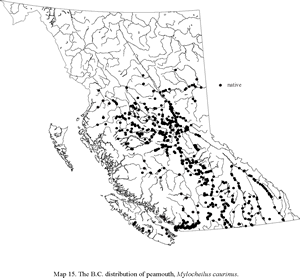A large minnow (adults reaching lengths of over 250 mm), with a small mouth, and barbels at the corners of the upper jaws; the dorsal fin originates in front of the pelvic fins; in juveniles the caudal fin is asymmetrical and deeply forked; adults have two dark banks on the flanks. Females are larger than males. For detailed description and discusion of this species, refer to McPhail (2008).
Source: FishBase. Page, L.M. and B.M. Burr 1991 A field guide to freshwater fishes of North America north of Mexico. Houghton Mifflin Company, Boston. 432 p.
